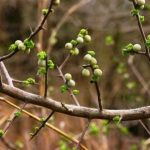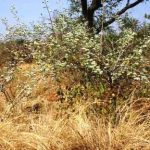TREE LIFE
September 1996
MASHONALAND CALENDAR
Tuesday 3rd September. Botanic Garden Walk at 4.45 for 5 p.m. We will meet Tom in the public car park of the Gardens. There will be a guard for the cars.
Sunday 15th September. The Msasas will be beautiful again and what better way to admire them than in Gosho Park which is the conservation area belonging to Peterhouse School in Marondera. Gosho Park is also the place of 3’s. So we should be able to find 3 Cussonia species, 3 Erythrina species and 3 Diospyros species; and why not 3 Maytenus and 3 Ficus species? Our last trip was in October 1992 when it was hot and dry, since then however we have had some decent rain so the bush should still be very beautiful.
Saturday 28th September. The last chapters of the amazing video by David Attenborough entitled “The Private Life of Plants” – Part 5 (Living Together) and Part 6 (Surviving) will be shown at Chisipite Girls High School. Bring your own refreshments for the break. Each part takes about ¾ hour, so we expect to be on our way home well before 5 o’clock.
Tuesday 1st October. Botanic Garden walk
Saturday 26th October. ‘Our miombo woodland’. An all day presentation at the Andy Millar Hall, Harare, by experts on various topics from birds to rats and other miombo mammals. Cost $165 and all profits will go to the Mukuvisi Woodlands Conservation Education Project. For more information please contact Meg Coates Palgrave.
MATABELELAND CALENDAR
Sunday 1st September. To the other side of the Matopos, out along the Kezi road. Meet at Girls’ College at 8.00 for departure at 8.30 a.m.
September 6-8. If you are interested in a visit to Shashe Wilderness Camp please contact Anthon Ellert or Gill Short. See Tree Life No. 198 for details.
Sunday 6th October. Visit to Clem Von Vliet’s old garden at Douglasdale now the garden of Mrs. Di Bott. Morning only, meet at Girls’ College at 8.30 a.m.
Sunday 3rd November. Possibly to the Brownlee-Walker’s farm near Shangani.
Alan Pearce
We record with regret the death on 20th July 1996, of Mr. Alan Pearce, who was for many years a trustee and committee member of the Society.
Alan might not have been known to some of our younger members because of the ill-health that has limited his movements for some time.
The Society has been the poorer for his absence. His wise counsel was always ours for the asking, and his gentle courtliness added grace to any company. To his most wonderfully devoted and gracious wife Ethie, and to the family, we extend our sympathy and condolences.
BOTANIC GARDEN WALK: 1 JUNE 1996
21 members gathered in the Botanic Gardens to hear Tom discuss and show us examples of the trees of the Eastern District outliers. These are areas outside the Eastern Districts, usually areas of high ground, where rainfall is usually high and a special flora may be found, often with species characteristic of the Eastern Highlands.
Most of these outliers occur on the SE side of the main watershed. Starting in the west and curving round in a NE direction there is the Matopos, Shurugwe, Mt Buchwa, Nyoni Hills, Zimbabwe Ruins, Bikita District and Wedza Mountain.
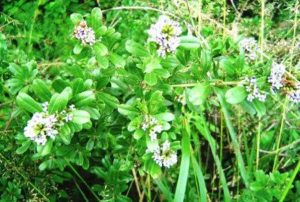
Otholobium foliosum. Photo Bart Wursten. Source: Flora of Zimbabwe
Another possible outlier is the Devedzo Range near Rusape. From these hills comes the only record in the Central Division of Otholobium foliosum, a shrubby legume common in grassland and scrub in the Eastern Districts. Perhaps a trip needs to be organised to investigate this.
Closer to home, the Domboshawa/Ngomakurira area of the Chinamora Communal Land is also an outlier. Because of the visit to Nyoni and Buchwa of the Tree Society in August, these areas were given most emphasis. Many of the species which occur in outliers are also frequent in higher rainfall areas generally. Two examples are Heteropyxis dehniae and Apodytes dimidiata.
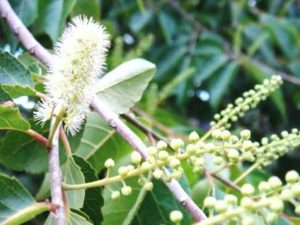
Bivinia jalbertii. Photo: Maureen Silva Jones. Source: Flora of Zimbabwe
Two very rare trees were looked at. Calantica jalbertii (formerly Bivinia jalbertii) and Warburgia salutaris. Calantica, in the Flacourtiaceae, is now nearly extinct, although it survives in the Nyoni Hills and possibly also in the Renco mine area. It has a trunk like a telegraph pole and may attain 40m.
It grows in evergreen gullies in woodland and because this particular habitat is rare, the plant is also. The seed has a hairy fringe.
Warburgia, Canellaceae, is also very rare, occurring only in the SE of Zimbabwe, although as it is very difficult to recognise, it may have been overlooked. The bark is looked on as a panacea and even the trees in the gardens had been attacked and have had numerous strips removed.
Oreobambos buchwaldii is a very rare bamboo, recorded in Zimbabwe only from Mt Buchwa, where it could be extinct following the collapse of mining residue down the side of the mountain. It is doing well in the Gardens although with no signs of flowering.
At Nyoni, Coddia rudis (formerly Xeromphis) is common. It is a small shrub, typical of outliers in the SE. Also at Nyoni is Strychnos henningsii. Tom informed us that this has a deep orange slash. It is similar to Strychnos mitis.
Space forbids mentioning all the many species examined. Once again, the walk was very useful preparation for a return to Nyoni.
Ipomoea toxicity
The many Ipomoea (Convolvulaceae) are well known either growing in the wild or as ornamentals due to their brilliant blossoms. Less well known are some of the toxic effects of plants in this genus.
Ipomoea alba (Ipomoea noctura – Moonflower)
The roots of this and some other Ipomoea species contain irritant resins which can have a drastic purgative action if consumed.
Ipomoea angulata (Ipomoea hederiflora)
This Ipomoea contains pyrrolizidine alkaloids which are damaging to the liver but no poisonings have been reported in the literature.
Ipomoea tricolor (Ipomoea violacea – Heavenly Blue Morning Glory)
This and some other Ipomoea species contain LSD-related alkaloids. The seeds contain up to 0.05% total alkaloids. Sellers of Ipomoea seeds in the USA dust the seeds with a noxious fungicide to deter consumption.
Ipomoea batatas (sweet potato; yam)
Mouldy sweet potatoes have given rise to poisoned cattle due to toxins produced by the contaminating fungus. The vines are rich in nitrates and can also be poisonous to livestock.
Ipomoea cairica
Has given rise to mild purging.
Ipomoea muricata
¬The seeds are purgative and may contain LSD derivatives.
Ipomoea lobata
The seeds contain ergot alkaloids which may have a hallucinatory effect. Ergots alkaloids are used in medicine e.g. for migraine, but toxicity limits their use.
Ipomoea multifida X (hearts-and-honey Morning Glory)
Contains ergot alkaloids. 33-69 grammes needed to have an effect.
-Douglas Ball
Why do young leaves flush out red?
In autumn trees prepare to drop their leaves by extracting many of the minerals and nutrients that can be recycled. The green chlorophyll is broken down and this may expose other colours that have been present in the leaf all along. To understand the red flush and new leaves we need to understand the relationship between molecules and light energy.
Molecules are composed of atoms joined together by a range of different bonds. The bonds may be single or multiple. The multiple bonds often have a natural vibration. If this vibration is the same frequency as a particular wavelength of light then this bond will absorb that wavelength and use its energy to vibrate. Each wavelength corresponds to a particular colour. When a molecule absorbs a particular wavelength the colour we see is the complementary colour. Complementary colours lie opposite each other on the colour wheel.
To construct a colour wheel, write down the three primary colours (red, blue and yellow ) in a triangle. Between each pair of colours record the colour that results from mixing paints of these colours – red and blue make purple, blue and yellow make green, yellow and red make orange.
These are the three secondary colours. These six colours constitute a colour wheel.
A pair of complementary colours consist of the primary colour and the secondary colour that lie opposite each other on the colour wheel – red and green, blue and orange, yellow and purple. These are strong combinations that are widely used in art and advertising to create striking effects.
The chlorophyll molecule in leaves absorbs red light. The plant uses the energy trapped in this way to make sugars. Because the red is absorbed, the leaf appears to be the complementary colour, which is green.
Plants cannot use green light, they reflect it. Therefore, a greenhouse constructed with green glass is a death trap for plants; they may as well be kept in a dark cupboard.
Under high light intensities too much red light may shine on a leaf. Some plants produce a natural screen that protects the chlorophyll molecules; this is a red water-soluble pigment called anthocyanin. Many succulent plants have red leaves when they are grown in full sunlight. The same red pigment protects some young leaves as they flush out. When the leaf expands and hardens, this protection is less important and the colour changes to green.
-Kim Damstra
GREAT DYKE: 21 JULY 1996.
Cross section through the Dyke
The Caesar Pass is a favourite venue with the Tree Society; however, a short distance to the south of the Caesar complex and roughly on the top of the Dyke, the edge of the 4th serpentine seam appear at the surface with the chrome seam running parallel to it. These chrome deposits with associated serpentine rock occur in 8 shallow bands (relatively speaking) across the Dyke. Here the ore is mined using a deep trench, in contrast to the deposits appearing on the sides of the hills where mining is carried out through a series of shallow stope shafts following the seam, sometimes appearing to be at precarious angles. Serpentine is a soft flaky rock with a pale green appearance and is often just below the thin topsoil providing a suitable habitat for the endemic Dyke plant species such as Euphorbia wildii, Ozoroa longipetiolata and the well known Aloe ortholopha. Due to the high mineral activity associated with serpentine, frequently calcium and magnesium, very little woodland occurs on these soils; however, you can generally find the pyroxenite which is the harder of the two rock types, by following the line of woodland.
To reach this place the road takes you past one of the fascinating dyke streams with crystal clear water, the high magnesium content keeping algae and the dreaded bilharzia at bay, thickly wooded banks with Syzygium guineense and a number of the palm Phoenix reclinata. At the seam Rob, denying any knowledge of geology, spoke convincingly with notes and a drawing to help us visualise the structure of the ore bodies. In this area three distinct zones occur with the remains of the exploited chromite seam colonised by Maesa lanceolata, grassland with a VERY squelchy vlei and typical Brachystegia woodland on the pyroxenite surrounding the vlei.
The extraction of chrome from this area ceased some thirty years ago but the stony mounds of overburden left behind from the trench mining are colonised by a variety of plants, especially those that relish well drained habits such as the wild violet Securidaca longipedunculata and a Protea petiolaris found by Liz Manser.
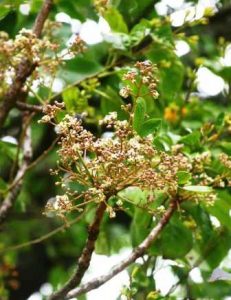
Ekebergia benguelensis. Photo: Bart Wursten. Source: Flora of Zimbabwe
Although patchy the trees along this geological band included the usual Lannea discolor, sundry Brachystegia, Faurea speciosa (now Faurea rochetiana, yes another name change). An Ekebergia benguelensis in new leaf had an excited Anne Bianchi exhorting us to examine the rounded leaves and stubby growing tips, these being the key to its specific identity. Beautiful but predatory Loranthus sp. with a blanket of red matchsticks smothering several Acacia karroo, leaving little doubt about the trees’ survival, to something small but of importance. The herb Scabiosa columbaria, with small white flowers and although a common resident around Harare it is, in this context, a coloniser of disturbed areas including the sterile confines of crushed serpentine, indicating considerable potential for its use on mine dump rehabilitation.
John Cottrill, evidently having read the latest issue of Tree Life, stepped up at one point asking if the plant in his hand could be ‘the vice of the Red Sea’ or better known as Catha edulis. He disappeared shortly after and we discovered him later chewing some leaves of this shrub hoping to experience the effects of ‘Qat’. Sorry John, wrong species. Douglas Ball also vanished at this time; not the Catha edulis but probably to avoid me as the time arrived to look around for a scribe cum contributor for Tree Life. For reasons unknown everything ground to a halt at 11.00 a.m. for tea, a very civilised habit but most unusual on the Tree Society outings and I suppose a tactic by the members of the Aloe Society to replace arboreal indigestion with normal ingestion.
The vlei fringes contained a few perennials such as a spiky mauve flowered Barleria sp. (a question for Mark or Bob), a few Acacia karroo, free of parasites but armed with enormous inflated spines that are associated with those growing on coastal zones, containing the remains of insect activity or a few startled spiders. Some of the other trees in this area of pyroxenite and banded ironstone are Rapanea melanophloeos with leaves in a rosette and with very pink petioles. The parsley tree Heteromorpha trifoliata, with variable leaves, slightly pungent Clerodendrum glabrum, Olax obtusifolia, Senna singueana, Diplorhynchus condylocarpon and Gardenia ternifolia to name a few.
A commendable action by the mining company concerned is that the gaping scars left for so many years from trench mining alongside the road through the dyke, have been filled in and planted with various trees to test their suitability for rehabilitation work in these difficult soil types. Species such as Acacia amythethophylla, Acacia karroo marked as Sweat Thorn, a spelling error no doubt, or could it be the reaction of someone wriggling away from the spines? Further test species are Acacia polyacantha, Rhamnus prinoides, Senna singueana, Tarchonanthus camphoratus and Rhus lancea have been planted in rows but where are our old friends Combretum molle and Pterocarpus angolensis which occur along this way at the base of these very hills?
On now to the final stop at the Caesar Pass, a steep and scenic place, however, this time to look at the magnificent splashes of orange and red flowers on the hillside. A solitary Aloe ortholopha x Aloe excelsa which, according to Mike Kimberley are the result of starlings pollinating the Aloe ortholopha with pollen from Aloe excelsa some distance away below the dyke hills. Some more flowering Euphorbia wildii with flowers and small 3-lobed fruit in stiff cup-shaped bracts.
With Werner’s back wheel testing the crumbling edge of the pass and Kenneth assembling his collection of a benign gecko, a highly aggressive orange centipede and a bemused little shovel snout snake, (all in bottles), it was time to head home.
A memorable day and our grateful thanks to Rob Croukamp for organising a most enjoyable and interesting outing. It has been a year since we met up with the Aloe Society – thank you all for joining us. Many thanks, too, to the geologist at Caesar Mine for the drawing showing the section and ore bodies of the Great Dyke.
-Douglas Ball
Botanic Garden Walk: 3 August 1996
18 members of the Society assembled in the Botanic Gardens car park on a breezy and surprisingly warm day. It was decided to look at the trees in the area between the car park and the new desert house.
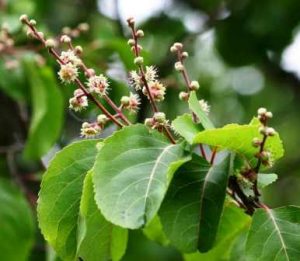
Homalium abdessammadii. Photo: Bart Wursten. Source: Flora of Zimbabwe
A broad shrub with leaves like a glossy Flacourtia caught our attention and this turned out to be the very rare Homalium abdessammadii. Tom explained that in Zimbabwe this occurs in the Victoria Falls rainforest at one or two places upstream, where it is under pressure. It is one of the rarest trees in Zimbabwe.
A remarkable fig with large leaves was Ficus trichopoda. This is not a Zimbabwean species; it occurs in South Africa. A fine medium-sized specimen of Ficus fischeri was seen – this is very rare species occurring to the SW of Chirinda towards the Save River.
The spectacular flowers of Fernandoa were appearing. Tom explained that although the Zimbabwean Fernandoa is still Fernandoa magnifica, the plants in the Gardens, which are from Malawi, are another species.
A tree with dark green paripinnate leaves was Entandrophragma utile, which is a heavily exploited timber species of tropical forests.
The single species of Burttdavya has large rather fig-like leaves and very large stipules indeed. It is a Rubiaceae with spherical flower heads, similar to, but larger than, Breonadia. The inflorescence has a delicious sticky fragrance. It is a rare species seen by Tom in Malawi.
Other plants seen were an extraordinary Nigerian variant of Margaritaria discoidea, Cola mossambicensis (the leaves bearing a prominent pulvinus which controls the direction in which the lamina faces), an attractive flowering Caloncoba welwitschii Flacourtiaceae, and the Kenya Croton Croton megalocarpus.
On reaching the desert house, Tom gave us a tour, showing the remarkable desert plants, mostly from Namibia but with some from the Cape. In all, there are 14 species of Commiphora, as well as species of Pachypodium, Adenium, Aloe, Euphorbia, Crassula and Pelargonium. In flower was a pink Sarcocaulon Geraniaceae with remarkable adaptations to its desert home – succulent stems and spines.
At this time of the year most of the plants are inactive. It will be very interesting to see what they look like as they produce leaves and flowers and also to see how dense the vegetation eventually becomes.
Once again, a fascinating walk, and our thanks go to Tom for sharing his knowledge with the Society.
-Mark Hyde
This extract from Flowering Plants of the World, consultant editor V. H. Heywood.
SAPOTACEAE
This large family of tropical trees yields timber and latex and edible fruits.
Distribution: the Sapotaceae occurs pan-tropically, mainly in lowland and lower montane rainforest.
Diagnostic features: white latex is present at least in the twigs, usually also in the bark, and is sometime copiously produced. The leaves are simple, entire, spirally arranged and often crowded in false whorls and sometimes with stipules which soon drop. The flowers are borne in fascicles, often behind the leaves or on the trunk; they are bisexual, regular or irregular, scented, often white or cream and are often nocturnal and bat-pollinated. The sepals are free, in two whorls or two, three or four, or one of five. The petals are usually equal in number to the sepals but usually in one whorl and are fused at the base. The stamens are epipetalous, either equal in number to and opposite the corolla lobes or more numerous, sometimes alternating with staminodes. The ovary is superior, of many fused carpels. The style is simple. The fruit is a berry, not articulated. The one or few seeds have an oily endosperm and bony testa and a large embryo.
Economic uses: Timber production is nowadays increasingly significant, for the Sapotaceae are an important component of many tropical rainforests (as in Malaya and Borneo), reaching 30 m tall and 2 m in girth. Some species have heavy timber, which is hard and naturally durable, but often siliceous; others have lighter timber, some without silica. Gutta-percha obtained from the latex of Palaquium species (especially Palaquium gutta of Sumatra, Malaya, Java and Borneo) was once the premier product of the family. It is a polymer of isoprene, differing from rubber by having trans- instead of cisisomerization, is almost non-elastic, a better insulator of heat and electricity becomes plastic on heating, and on cooling remains any shape given while hot. It was developed in the 19th century from a minor curiosity to a major industrial product, principally as an insulant for submarine telephone cable, but also used in golf balls, and for temporary dental stoppings (only the last use still persists). The latex was mostly obtained by tapping trunks in a herring-bone pattern. Early destructive tapping was followed by efforts for conservation and some plantations were established, as in Java and Singapore.
Mimusops balata (Manilkara bidentata) of northern South America also yields a latex, balata, formerly of considerable importance. Chicle, the elastic component of earlier chewing gum, is produced from the latex of Achras zapota (Manilkara zapota). Achras zapota also yields the popular edible fruit chiku or sapodilla plum, and Chrysophyllum cainito the star apple; both are of American origin but now planted elsewhere in the humid tropics. Some of the fruits termed sapota are the product of Calocarpum species, notably Calocarpum sapota.
The seeds of the north tropical African Butyrospermum paradoxum, the shea butter tree, yield an edible oil.
-T. C. W.
Some meanings and origins of names from W.P.U. Jackson’s book.
Sideroxylon. From the Greek sideros, iron; xylon, wood; referring to the hard wood.
Chrysophyllum. Greek chrysos, gold; the leaves of some species are covered with golden hairs.
Mimusops. From the Greek mimo, an ape; -opsis, resembling; referring to the shape of the corolla and/or the colouring of the flowers.
Vitellariopsis. Resembling (opsis) Vitellaria, previous name for a genus in the same family; from the Latin vitellus, yolk of an egg.
Inhambanella. From its place of origin, Inhambane in Mozambique; plus diminutive.
Some species of the SAPOTACEAE family found in Zimbabwe:-¬
Sideroxylon inerme WCES
Pachystela brevipes E
Aningeria adolfi-friedericii E
Chrysophyllum gorungosanum E
Chrysophyllum viridifolium E
Afrosersalisia kassneri E
Englerophytum magalismontanum NWCES was Bequaertiodendron)
Englerophytum natalense E
Mimusops obtusifolia ES
Mimusops zeyheri NWCES
Manilkara concolor S
Manilkara discolor E
Manilkara mochisia NWCES
Vitellariopsis ferruginea ES
Inhambanella henriquesii E
The nursery at La Rochelle is being revived and we have received a request for seeds of indigenous trees. If you are able to collect some while out on your ramblings they would be very welcome. Either send them direct to the head gardener at La Rochelle, P 0 Box 34, Penhalonga, or to the Tree Society at P 0 Box 2128 Harare.
ANDY MACNAUGHTAN CHAIRMAN


